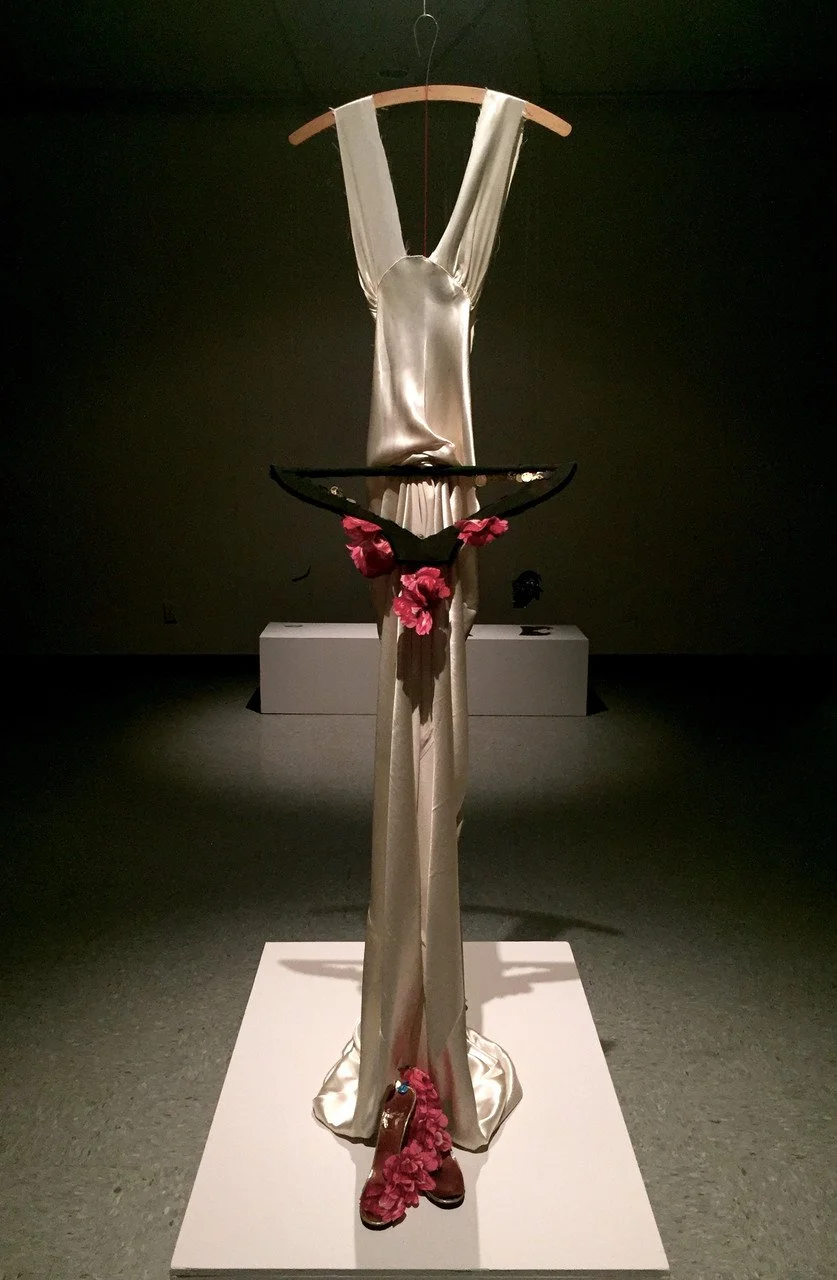
Lillien Waller x Mariam Ezzat
Her Heart Will Be Weighed and Measured
The Living Sculptures of Mariam Ezzat
Standing wordless in a cream-colored silk charmeuse gown, her hem billows around her feet. A gold coin and a few blue ceramic beads rest on the tip of gold lamé heels and a bouquet of red and pink cloth flowers vine across both shoes toward the tips of her toes. A black, upside-down vintage hanger suspends from her waist, dotted with the same flowers.
This is what longing looks like, a breath ready to be taken.
She could be a chanteuse from a distant era, waiting to arrive under warm stage lights. Or she could be a modern-day Misirlou, the “Egyptian girl” and object of desire in the traditional Greek folk song of the same name. “Misirlou” (2015) is the central, human-scale figure in a triptych of sculptures by 2019 Kresge Visual Arts Fellow Mariam Ezzat. The sculpture—or, as Ezzat calls her three-dimensional artworks, assemblage—faces another, “Anubis” (2015), a reference to the Egyptian god of death and the afterlife.
“Anubis” is a pendant-like structure made of various jewelry parts, pearls, satin and silk, suspended on threads above high-heeled silver shoes resting on a large swatch of cloth. All that remains are a coin, two pearls and the tiniest ankh, Egyptian symbol of eternal life, hanging delicately from a metal anklet draped around the right shoe’s collar.
Mariam Ezzat, Misirlou, 2015, satin, vintage hangers, scarf, ink, shoes, coins, thread, ceramic beads
Do these remnants belong to the Egyptian girl who stands before Anubis waiting to be judged? His shadow, cast on the wall behind the assemblage, is as powerful as the figure itself.
“That piece was about the death ritual [of Ancient Egyptians] and the goddess Maat,” Ezzat explains, noting that our hearts hold our virtues as well as our sins. “She’ll weigh your heart, and if it’s lighter than a feather, you can ascend to heaven. But if it’s heavier, they’re going to kill you with demons.” Ezzat’s laughter fills the room. She describes her youthful—and, in an observant Muslim home, far-fetched—dream of becoming a belly dancer, the subject of the third sculpture, “What is Left of a Belly Dancer in Hell” (2015). A dancer’s black beaded bra, a vintage hanger, and a silver anklet hang by diaphanous threads from the ceiling. I can’t decide if together these items form a declarative sentence or a lingering question.
It would be a mistake to think of Ezzat’s assemblages as purely autobiographical, although their interior “lives” resemble aspects of her own. They are as much about her as they are about her mother, an Egyptian immigrant, other women in her family, or female archetypes. They are also often imaginary, or mostly, like the three women gathered in the corner of her eastside Detroit apartment. (Ezzat always refers to the sculptures as “she” or “her.”) But even as they hug the walls wearing manipulated vintage garments, bits and bobs from Ezzat’s apartment and jewelry from an artist she likes—including a Coca Cola® charm dangling in one sculpture’s eye—they have presence.
“The pleasure of sculpture happens first in hands that would touch: texture and shape; later in muscles that would lift: bulk, volume, heft,” the late poet Donald Hall mused. Ezzat’s sculptures, her assemblages, feminize Hall’s observation: they induce empathy. Yes, they exist in the room with us, volumes in space, and we “observe” them with our hands. But, in doing so, we confront their tangible physicality with our own humanity.
That is certainly the case with the materiality of Ezzat’s series Archetypes from 2019, where sugar maple branches extend into the leather boots of “The Prostitute,” or a wicker chair swathed in a chiffon prayer scarf and embroidered gloves recalls “The Victim.” Who can deny the charged motifs of the “fallen woman” we still wear like a ball and chain? Is it grace we have lost or the mandate of domesticity?
Left: Mariam Ezzat, What is Left of a Belly Dancer in Hell, 2015, belly dancer bra, vintage hanger, silver anklet, thread, resin. Center: Mariam Ezzat, Anubis (detail), 2015, jewelry parts, pearls, coins, thread, satin, shoes, silk, crystal. Right: Mariam Ezzat, The Victim, 2019, chiffon prayer scarf, wood and wicker chair, vintage hangers, embroidered gloves, prayer rug, vintage novelty rings, incense holder, copper wire, enamel, souvenir pyramids
And this: Ezzat’s sculptures are also whimsical and sexy and don’t always take themselves too seriously—like the last-call ladies in her living room, awaiting their roles in an upcoming group show at Wayne State University—especially while they’re dropping dimes about the ridiculousness of female display in pop culture.
“I think sexiness as a joke is a part of it, too, coming from a strict Muslim household” Ezzat says, “I remember seeing sexiness as a quality that made me feel like, ‘I wish I could be like that. That’s cool. That’s something that I want to do.’ And then eventually being in on this joke, realizing, ‘Oh, this isn’t cool at all.’ But there’s a part of it that’s hilarious,” she says, erupting into laughter. “And as I get older, as a woman, especially, a huge part of it is the idea of being on display, the idea of figuring out what your role is, the idea of having kids or not having kids, the idea of being able to choose if you do. The idea of being married or not being married. The idea of domesticity. What does any of it mean?”
About the series:
Practice is a series of profiles that consider and amplify the distinctive voices of Kresge Artist Fellows. Each essay is the culmination of long-play conversations with Detroit artists who generously examine their own creative practices and who ask interesting questions of society, culture, and themselves.
About the author:
Detroit native Lillien Waller holds an MFA in poetry from Sarah Lawrence College and degrees from University of Michigan, New School for Social Research, and Emory University. Her poems have been nominated for the Pushcart Prize and Best New Poets, and she is editor of the anthology American Ghost: Poets on Life after Industry (Stockport Flats). Waller’s interdisciplinary work has been shown at Wasserman Projects in Detroit and as part of Wayne State University’s public art series In the Air II (2021–22). She has written on a range of topics—including contemporary visual art and design, modern art history, public policy, social justice issues, and American, Caribbean, and European studies—and profiled dozens of artists, scholars, and entrepreneurs. Waller is a Cave Canem Fellow (2001) and a Kresge Artist Fellow in Literary Arts (2015).








